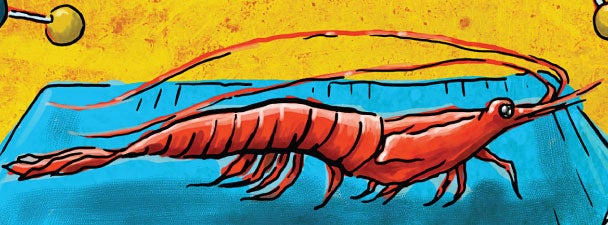 Last summer, what was once the darling of YouTube suddenly became the poster child for lavish government spending. We asked our marine biologists to talk about their shrimp on a treadmill experiment, their newfound notoriety and why scientific research is worth every penny.
Last summer, what was once the darling of YouTube suddenly became the poster child for lavish government spending. We asked our marine biologists to talk about their shrimp on a treadmill experiment, their newfound notoriety and why scientific research is worth every penny.
by Lou and Karen Burnett
It was our first encounter with Washington politics, nasty Washington politics.
We were innocently driving in the Shenandoah Valley, enjoying the long Memorial Day weekend with family and friends, when we received a call. It was a CNN reporter asking if we had any comment on U.S. Senator Tom Coburn of Oklahoma’s report criticizing the National Science Foundation (NSF) and discounting our NSF-funded research project as “silly science.” (See “Shrimp on a Treadmill: The Politics of ‘Silly’ Studies,” featured on NPR.) In an instant, we became the poster children for abuse in government spending.
The Coburn report suggests that the federal government gave us over half a million dollars to find out how long shrimp can run on treadmills. Unfortunately, Sen. Coburn did not bother to do his own research. No one from his office contacted us to ask about our work, nor did he bother to check with the NSF itself to find out exactly what the foundation spent its money on. Had he done so, he would have learned that shrimp treadmills are a small part of a much larger program of study. Instead, our research was misrepresented and taken out of context.
 Back to our world in Charleston, where fish kills (mass death of fish in a specific place) are relatively common occurrences and the public understands that when bad things happen in the water, fish and shellfish die. Cause and effect. Unfortunately, bad things happen to organisms all the time. This is true in the marine environment and especially so in coastal waters. Humans populate coastal areas in high numbers– and, since the earth is now a habitat for more than 7 billion people, these coastal waters are heavily impacted by human activities, especially farming, industrialization, urbanization and even recreation.
Back to our world in Charleston, where fish kills (mass death of fish in a specific place) are relatively common occurrences and the public understands that when bad things happen in the water, fish and shellfish die. Cause and effect. Unfortunately, bad things happen to organisms all the time. This is true in the marine environment and especially so in coastal waters. Humans populate coastal areas in high numbers– and, since the earth is now a habitat for more than 7 billion people, these coastal waters are heavily impacted by human activities, especially farming, industrialization, urbanization and even recreation.
The public gets this. What is perhaps less commonly explained are events that cause fish, dolphins or other organisms to be not killed, but made sick. So, while the cause is often low oxygen or the presence of a particular pollutant, the effect is not always a complete fish kill. Mortality events such as fish kills are extreme events.
The two of us have studied marine organisms for decades and have combined our different strengths as scientists in organismal physiology and immunology to find out how organisms work and how they respond to their environments and the stresses they encounter as they live their lives.
The fun part is discovering something that no one has even thought of before. It’s also fun to collaborate with our students and other scientists to define what’s important, how we can approach a problem and how we can advance science. After all, advancing science is what the public expects of its investment in the scientific enterprise.
Doing science well is challenging. And, these days, doing science is a collaborative endeavor. This is why we believe it’s important to prepare our College of Charleston students to work with other scientists by training them to put research in the context of the whole organism. This means that – even though we might study the molecular biology of an organism’s particular response or the resulting change in its behavior in response to something like low oxygen – the organism and its relation to its ecology is paramount. We have a large toolbox for doing science, and we enjoy a variety of approaches, from studying molecules to researching organismal behavior – which includes measuring responses of organisms exercising on treadmills.
Biologists have used treadmills for decades to understand animal locomotion. Just about everything – from cockroaches to lizards to horses – has been placed on a treadmill. Not only is the treadmill a marvelous tool for understanding how organisms can interact with their environment, but it provides a superb way to talk with nonscientists about our work. After all, using treadmills for stress tests is something the public readily understands.
Enter shrimp treadmills. A few years ago, our colleague David Scholnick – who at the time was on the faculty at Eckerd College – decided to spend a part of his first sabbatical with us. David had been an undergraduate student of one of us (Lou) at the University of San Diego back in the 1980s and had gone on to do some work on reptiles as a postdoctoral researcher at the University of Colorado. This work involved placing lizards on treadmills. Aware of our work on crustaceans, David built an underwater treadmill and brought it to Charleston.
The treadmill was designed for shrimp, but we didn’t exactly know how they would respond. When the tread below our first shrimp began to move, the shrimp began walking. When we increased the speed of the tread, it galloped – and then at higher speeds, it swam. It swam for hours.
The early video of our shrimp on a treadmill became a YouTube sensation and attracted attention to our work, which is likely how Sen. Coburn (or, more likely, his staff) learned of it. Had he contacted us, we would have explained how the treadmill studies fit into our overall research efforts.
Our research – which has been funded from a variety of sources, including the NSF, the U.S. Department of Agriculture and the National Oceanic and Atmospheric Administration – in general has taught us that shrimp, crabs and lobsters (and also oysters and fish) have difficulty in resisting bacterial infections when they encounter low oxygen and elevated carbon dioxide in their natural environment. And low oxygen and high carbon dioxide are direct results of human activities. Coastal waters contain large numbers of bacteria (and viruses); one teaspoon of water can contain more than one million bacteria. Interestingly, we have learned that in crustaceans, the very act of launching an immune response against these challenges interferes with their abilities to carry out normal activities in the wild, such as pursuing prey, avoiding predation and engaging in reproductive activity.
While the thrust of what we do is considered basic research, the organisms we work on are important economically. Our test shrimp are the most commonly aquacultured shrimp in the world. The Atlantic blue crab, which also walks on our treadmills, is an important fishery in Charleston and on the Atlantic and Gulf of Mexico coasts.
We strongly believe that the investment that society has made in our work has advanced science and produced some important findings. We have a much better understanding of how marine organisms make a living in coastal waters. Just like when your doctor puts you on a treadmill to find out about your health and how fit you are, we put marine organisms on miniature treadmills to learn about their health and the health of our environment. And now we have a more complete picture of how far organisms can be pushed before things go too far.
– Lou and Karen Burnett both work at the College’s Grice Marine Laboratory on James Island,
where Lou is a biology professor and Karen is a research associate and adjunct faculty member.
Illustration by Baird Hoffmire




